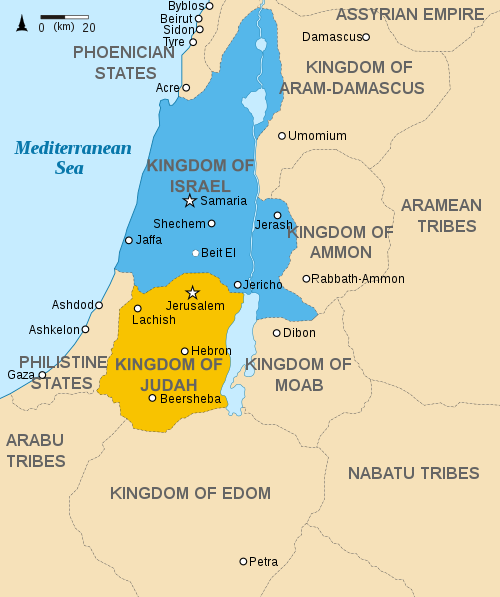Judah
The Kingdom of Judah was an ancient Israelite kingdom that existed in the southern part of the Levant.[1][2] It was on the western shore of the Dead Sea. Its main cities were Jerusalem and Hebron. It existed from the 9th[3][4] or 8th century BC,[1][5] up until 586 BC.[2][4]
Kingdom of Judah | |||||||||
|---|---|---|---|---|---|---|---|---|---|
| 9th or 8th century BCE–586 BCE | |||||||||
 Map of the region in the 9th century BCE | |||||||||
| Capital | Hebron Jerusalem | ||||||||
| Common languages | Hebrew | ||||||||
| Government | Monarchy | ||||||||
| Historical era | Levantine Iron Age | ||||||||
• | 9th or 8th century BCE | ||||||||
• | 586 BCE | ||||||||
| |||||||||
After the death of Saul, Israel picked David to rule them. (1 Chronicles 11:1) After the death of King Solomon, son of David, ten of the twelve of the tribes of Israel did not want Solomon's son, Rehoboam to lead them. This caused the kingdom to split the Northern Kingdom, the Kingdom of Israel and the Southern Kingdom, the Kingdom of Judah. Jerusalem was the capital of the Kingdom of Judah.[1][4] In 586 BC, the king of Babylon, Nebuchadnezzar II, took over Jerusalem and destroyed Judah.[2][4]
Related pages
References
- ↑ 1.0 1.1 1.2
- Maisler, B. (1952). "Ancient Israelite Historiography". Israel Exploration Journal. Israel Exploration Society. 2 (2): 82–88. JSTOR 27924468. Retrieved January 16, 2025.
- Porter, J. R. (1981). "Ancient Israel". Divination and Oracles (1 ed.). Routledge. ISBN 9781003242758. Retrieved January 16, 2025.
- Crenshaw, James L. (1985). "Education in Ancient Israel". Journal of Biblical Literature. The Society of Biblical Literature. 104 (4): 601–615. doi:10.2307/3260674. JSTOR 3260674. Retrieved January 16, 2025.
- Davies, Philip R.; Fritz, Volkmar (1996). The Origins of the Ancient Israelite States. Bloomsbury Publishing. Retrieved January 16, 2025.
- Clements, Ronald E. (1991). The World of Ancient Israel: Sociological, Anthropological and Political Perspectives. ISBN 9780521423922. Retrieved January 16, 2025.
- ↑ 2.0 2.1 2.2
- "Israelite History in the Context of the Ancient Near East". Boston University. 2004. Retrieved January 16, 2025.
- Brown, William (July 13, 2017). "Ancient Israelite & Judean Religion". World History Encyclopedia. Retrieved January 16, 2025.
- David, Ariel (April 28, 2024). "Archaeologists Find Cemetery Possibly Linked to the Ancient Israelites". Haaretz. https://www.haaretz.com/archaeology/2024-04-28/ty-article-magazine/archaeologists-find-cemetery-possibly-linked-to-the-ancient-israelites/0000018f-2344-dacd-a7ef-37c510fb0000. Retrieved January 16, 2025.
- Tercatin, Rossella (October 27, 2024). "Was literacy important in the biblical Kingdom of Judah? Expert offers answers". The Jerusalem Post. https://jpost.com/archaeology/article-826336. Retrieved January 16, 2025.
- "Israelite | Definition, Tribes, & Bible". Britannica. December 20, 2024. Retrieved January 16, 2025.
- ↑
- Lester L. Grabbe, ed. (2008). Israel in Transition: From Late Bronze II to Iron IIa (c. 1250–850 B.C.E.). T&T Clark International. pp. 225–6. ISBN 978-0567027269.
- ↑ 4.0 4.1 4.2 4.3
- Malamat, Abraham (1990). "The kingdom of Judah between Egypt and Babylon: A small state within a great power confrontation". Studia Theologica - Nordic Journal of Theology: 65–77. doi:10.1080/00393389008600087. Retrieved December 9, 2024.
- Schoors, Antoon; Lesley, Michael (2013). The Kingdoms of Israel and Judah in the Eighth and Seventh Centuries B.C.E. Society of Biblical Literature. doi:10.2307/j.ctt5hjgzr. JSTOR j.ctt5hjgzr. Retrieved December 9, 2024.
- Schipper, Bernd U. (July 19, 2013). "Egypt and the Kingdom of Judah under Josiah and Jehoiakim". Journal of the Institute of Archaeology of Tel Aviv University. Humboldt University, Berlin. 37 (2): 200–226. doi:10.1179/033443510x12760074470865. Retrieved December 9, 2024.
- Na'aman, Nadav (February 17, 2014). "The Kingdom of Judah in the 9th Century BCE: Text Analysis versus Archaeological Research". Journal of the Institute of Archaeology of Tel Aviv University. 40 (2): 247–276. doi:10.1179/033443513X13753505864331. Retrieved December 9, 2024.
- Rotaru, Ioan-Gheorghe (2015). "Historical and biblical features of the last five kings of the Kingdom of Judah". Dialogo. EDIS – Publishing Institution of the University of Zilina (1): 231–239. Retrieved December 9, 2024.
- ↑ Finkelstein, Israel (2006). "The Last Labayu: King Saul and the Expansion of the First North Israelite Territorial Entity". In Amit, Yairah; Ben Zvi, Ehud; Finkelstein, Israel; et al. (eds.). Essays on Ancient Israel in Its Near Eastern Context: A Tribute to Nadav Naʼaman. Eisenbrauns. pp. 171 ff. ISBN 9781575061283.
